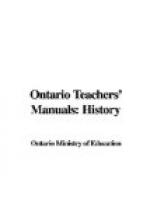However, as McMurry points out, we are in a peculiarly favourable position in Canada, because we have in our own history, in the comparatively short time of 400 years, the development of a free and prosperous country from a state of wildness and savagery. The early stages of our history present those elements of life that appeal strongly to children—namely, Indians with all their ways of living and fighting, and the early settlers with their simpler problems and difficulties. The development of this simpler life to the more complex life of the present can be more readily understood by children as they follow up the changes that have taken place. (See McMurry, Special Method in History, pp. 26-30.) Of course, at every step appeal must be made to the experiences of children, as the teacher knows them. In Civics, however, the beginning must be made with conditions that exist to-day—schools, taxes, the policeman, the postmaster, etc. The beginning of the real teaching of history may then be made at the beginning of Canadian History, as this will enable the child to go gradually from the simple, or individual, to the complex, and will also allow the teacher to make use of whatever historical remains may be within reach.
CHAPTER II
GENERAL METHODS IN THE TEACHING OF HISTORY
There are many methods used in the teaching of history. A brief description of the principal ones is given for reference merely, since their best features are incorporated in a combination of methods, which is strongly recommended to teachers, and is described fully in succeeding pages.
1. Methods based on the arrangement and selection of the matter: Chronological, Topical




